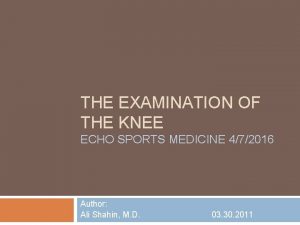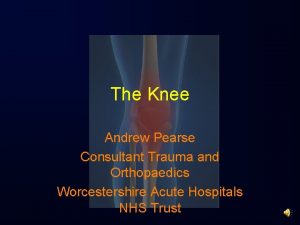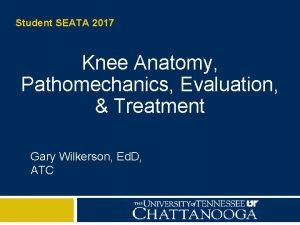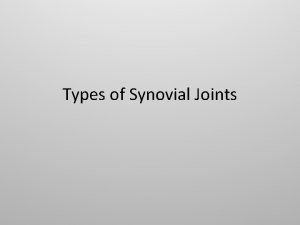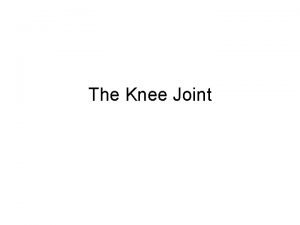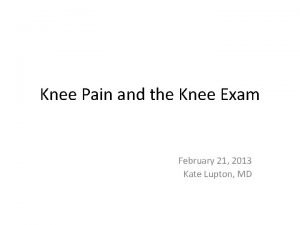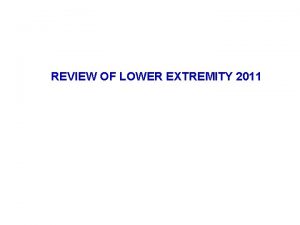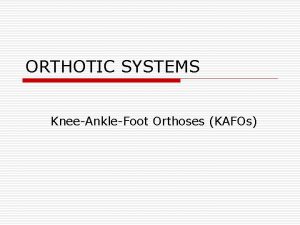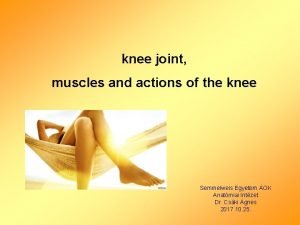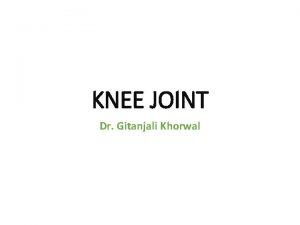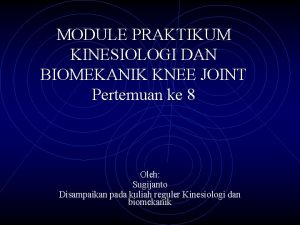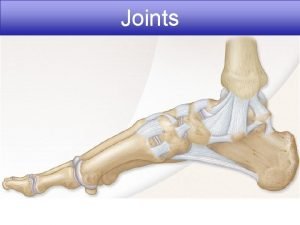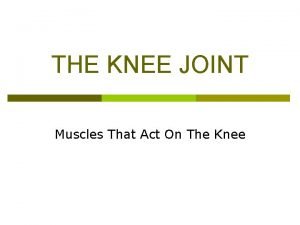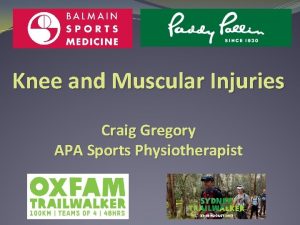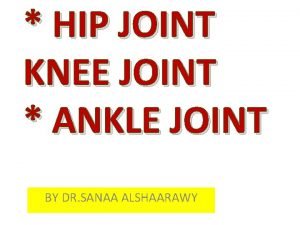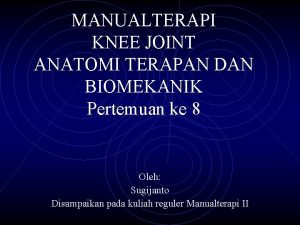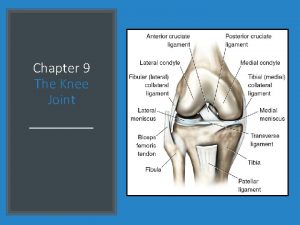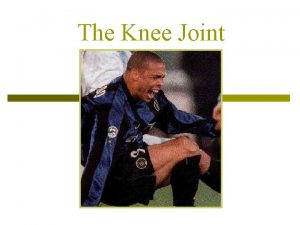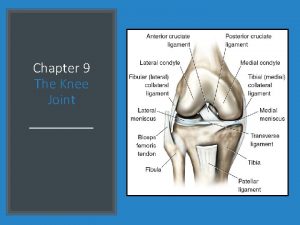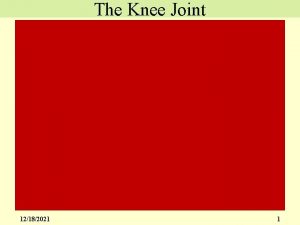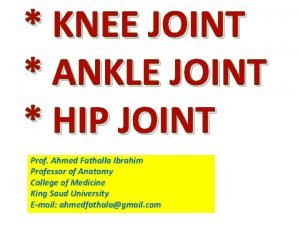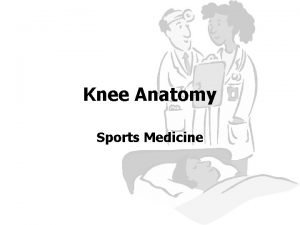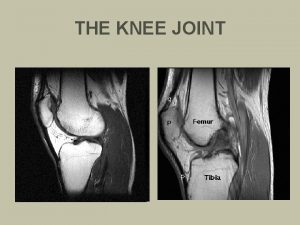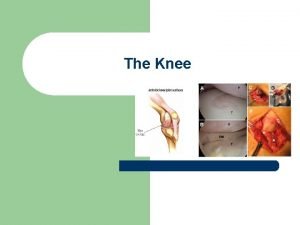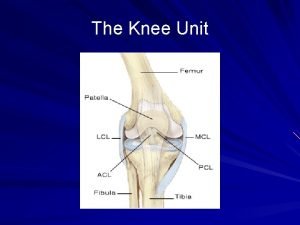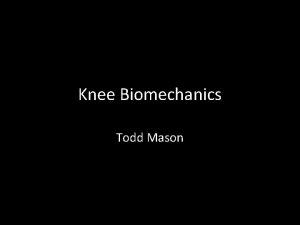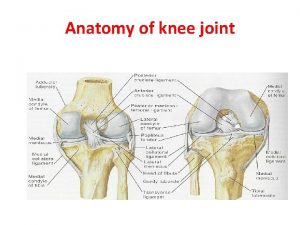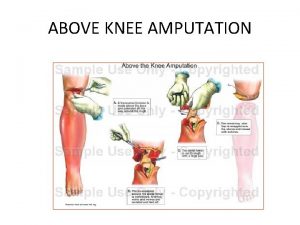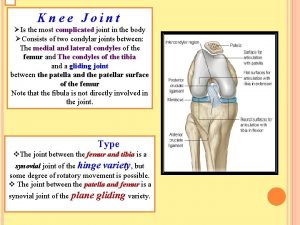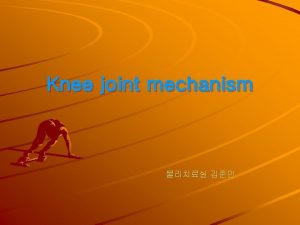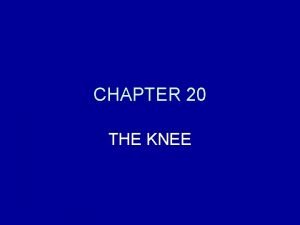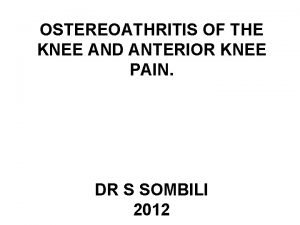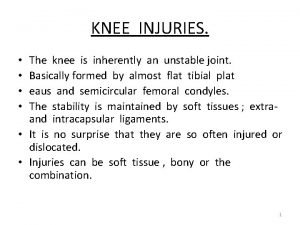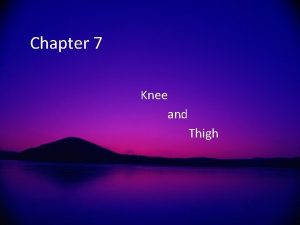The Knee Joint The Knee Joint p p

























- Slides: 25

The Knee Joint

The Knee Joint p p Hinge joint? Double-condyloid joint n n p The locking of the knee into full extension is often referred to as the “screw home” movement n n p Flexion and Extension Internal and External Rotation Tibia externally rotates 10 degrees Biceps femoris Initial flexion of the knee, the knee “unlocks” n n Tibia internally rotates Popliteus, semitendonosus, semimembranosus

Two-Joint Muscles p Uniarticulate n p A muscle that crosses one joint Biarticulate n A muscle that crosses two joints

Two-Joint Muscles Two-joint muscles are most effective when either the origin or insertion is stabilized. p Why? p Explain the benefit of leaning backwards while kicking a ball. p

Two-Joint Muscles A muscle's ability to contract dependent upon its length, or degree of contraction. p A muscle can contract more forcefully when it is slightly stretched. p Muscle generates maximal concentric tension at a length 1. 2 times its resting length. p

Two-Joint Muscles p p p During knee FLEXION, what muscle group is being stretched? What affect will this have on that muscle groups ability to contract? During knee EXTENSION, what muscle group is being stretched? What affect will this have on that muscle groups ability to contract? How do these relationships help during running?

Quadriceps p p The quadriceps function as a decelerator when it is necessary to decrease speed for changing direction or running downhill or to prevent falling when landing. What type of contraction does deceleration require? What ultimate affect does this type of contraction have on muscle strength? What ultimate affect does this type of contraction have on muscle soreness?

Quadriceps p p p What is a typical test that measures the strength of the quadriceps muscles? Strong quadriceps muscles are essential for maintenance of patellofemoral stability The vastus medialis muscle is not emphasized until the last 10 -20 degrees of knee extension

Acute Knee Injuries

Causes of ACL Injuries p p Cutting (rotation) Hyperextension n Straight knee landing n When the knee is extended, the ACL is at it’s maximal length putting it at an increased risk of tearing

Unhappy Triad 1. 2. 3. ACL Medial collateral ligament Medial meniscus

Lachman Test and Anterior Drawer Test Normal knees have 2 -4 mm of anterior translation and a solid end point p ACL injury will have increased translation and a soft end point p

Chronic Injuries 1. 2. 3. 4. 5. 6. Patellar Tendonitis Patellofemoral Pain Syndrome Subluxation of Patella Chondromalacia Osgood-Schlatters Disease IT Band Syndrome

Patellar Tendonitist

Patellar Tendonitist p p p Due to high deceleration or eccentric forces of the quadriceps at the knee during landing As you land the hamstrings cause your knee to flex to absorb the shock of impact In order to control or decelerate the flexion produced by the hamstrings, the quadriceps muscles contract eccentricly Eccentric contractions occur as the muscle is being lengthened or stretch Eccentric contractions produces high amounts of force, and therefore stress to the patellar tendon

Patellar Tendonitist p Prevention: strong quadriceps muscles Squats Lunges

More Quadriceps Exercises Leg Extension Leg Press

More Quadriceps Exercises Plyometric or Jump Training Uphill Running

Hamstring Exercises

Hamstring Exercises

Chondromalacia p p p This is a Latin term meaning “bad cartilage” or breakdown or softening of the articular cartilage of the patella The cartilage surface on the underside of the patella becomes soft. Part of the cartilage can become stringy and flake off at times. Part of the surface may become roughened. Causes (FYI) 1. Training errors p 2. 3. Weak vastus medialis muscle Large Q angle p 4. 5. 6. Increasing intensity too soon Greater than 25 for women and 20 for men Pronation of the foot causing the tibia to medial rotate Gender - more common in women Poor footwear and/or surface

Patellofemoral Stability

Osgood- Schlatter Disease p p p Overuse, not a diesease. Inflammation to the patellar tendon at the tibial tuberoscity Most common in adolescents (8 -13 year olds girls and 10 -15 year old boys); age of rapid bone growth

Osgood- Schlatter Disease Anterior pain about 2 -3 inches below the patella p Avulsion fracture p

IT Band Syndrome Excess duration or time exercising p Hip abductor weakness p Tight hip abductors and/or IT band p
 Knee palpations
Knee palpations Andrew pearse
Andrew pearse Knee joint ligaments
Knee joint ligaments Locking and unlocking of knee joint
Locking and unlocking of knee joint Hip synovial joint
Hip synovial joint Oblique popliteal ligament
Oblique popliteal ligament Full knee rest position
Full knee rest position Knee palpations
Knee palpations Long plantar ligament
Long plantar ligament Disadvantages of suspension therapy
Disadvantages of suspension therapy Orthotic knee joint stainless steel ring drop lock
Orthotic knee joint stainless steel ring drop lock Arthrography
Arthrography Coxa valga genu varum
Coxa valga genu varum Coronary ligament
Coronary ligament Biomekanik knee joint
Biomekanik knee joint Nonaxial uniaxial biaxial multiaxial
Nonaxial uniaxial biaxial multiaxial Vastus lateralis m
Vastus lateralis m Leg tendons and ligaments
Leg tendons and ligaments Lateral rotation of thigh muscles
Lateral rotation of thigh muscles Anatomi knee joint
Anatomi knee joint Venture meaning in accounting
Venture meaning in accounting Lamb grading chart
Lamb grading chart Lamb grading chart
Lamb grading chart What type of joint is the intervertebral joint
What type of joint is the intervertebral joint Hinge joint
Hinge joint Which is not a permanent joint
Which is not a permanent joint
